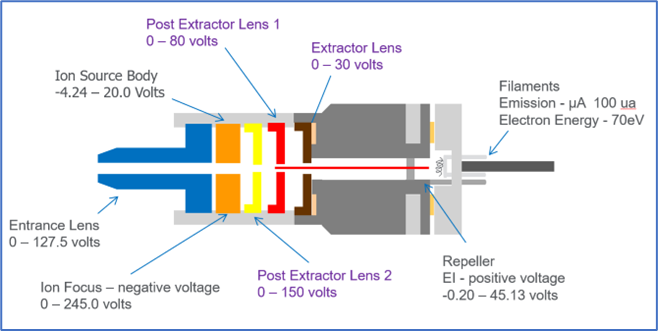Which Electron Ionization Source Part 1 had questions. Which Electron Ionization Source Part 2 had some answers. Now, let’s talk about each source and tuning.
Stainless Steel/Inert vs. Extractor, Atune vs. Etune - The colored lines in the diagrams (Figure 1 and Figure 2) are representing the electrostatic fields on the lenses.
Atune:
- Stainless Steel/Inert: The ion body, drawout plate, and drawout cylinder are at ground all the time.
- Extractor: The ion body and extractor are set to ground in the electronics.
- Positive ions created by the passage of electrons are repelled by the positive voltage applied to the repeller.
- Many positive ions will crash into the ion body and drawout or extractor, both of which are at ground.
- The ions that make it through the hole in the drawout or extractor are focused by the ion focus and then by the entrance lens before going into the quad.
- The entrance lens has a +4.4 V VDC offset, the adjustable entrance lens offset, and the entrance lens voltage. These push the positive ions towards the center of the axis and help direct them into the quad.
- The vertical red line is the path of the electrons.
So, in Atune, the lenses of both types of sources function identically.
Etune with the Extractor and HydroInert source:
- The ion body and extractor are each ramped separately as part of the tune algorithm.
- The ion body is at a positive voltage. This pushes the positive ions created by the passage of electrons towards the center of the ionization chamber.
- The positive ions are repelled by the positive voltage applied to the repeller.
- The ion body and repeller ramps are codependent. Changing one affects the performance of the other.
- The extractor lens voltage bias pulls the positive ions towards it, helping them towards and through the hole.
- The ions that make it through the hole in the extractor are focused by the ion focus and then by the entrance lens before going into the quad.
- The vertical red line is the path of the electrons.
More ions are transmitted into the quadrupole using Etune than using Atune. This does not help all molecular weight ions the same, so an Etune has a different spectral tilt than an Atune.

Figure 1 - Autotune (Atune) versus Extractor Tune (Etune)
The High Efficiency Ion Source (HES) is an axial design. The HES tune algorithm works very much like the Extractor tune algorithm, but the physics are different due to the mechanical design.
- The horizontal red line is the path of the electrons. They are reflected back to the filament by the post extractor lenses.
- The ion body and extractor are each ramped separately as part of the tune algorithm.
- The ion body is at a positive voltage. This pushes the positive ions created by the passage of electrons towards the center of the ionization chamber.
- The positive ions are repelled by the positive voltage applied to the repeller.
- The ion body and repeller ramps are codependent. Changing one affects the performance of the other.
- The extractor lens voltage bias pulls the positive ions towards it, helping them towards and through the hole.
- The ions that make it through the hole in the extractor are focused by the ion focus and then by the entrance lens before going into the quad.
More ions are transmitted into the quadrupole using the HES than the SS/Inert or Extractor/HydroInert ion sources.

Figure 2- High Efficiency Ion Source
The negative ions that are also created crash into the surfaces in the ionization chamber – repeller, ion body, drawout, or extractor. Some react again and end up non-ionized. The non-ionized molecules, the vast percentage of everything that enters the MS, crash into the surfaces in the ionization chamber and also crash, bounce, or bounce and stick, until they either stick and stay or eventually bounce into the high vacuum pump to be pumped away. The positive ions that don’t crash into the drawout plate or extractor lens and aren’t focused properly by the ion focus do the same thing. All of this stuff goes everywhere inside the vacuum chamber. This is the primary reason that the ion source needs to be cleaned frequently. Eventually every surface inside the vacuum chamber must be cleaned or replaced as that adhered contamination redistributes over time. If the system is dirty, a freshly cleaned source gets dirty just from being installed.
- Systems not designed for use with the extractor ion source or HES use the Stainless Steel or the Inert ion source for EI. [5975x and 7000A/B systems. 5977x systems see below]
- Systems designed for use with the extractor ion source can be fitted with the Stainless Steel, Inert, Extractor, and the HydroInert ion sources for EI. [7000C/D/E systems. 5977x systems see below]
- Systems designed for use with the HES can only use the HES for EI. [7010A/B/C systems. 5977B/C systems]
- 5977A/B/C systems - the ion source that can be used depends on the version purchased.
Stay tuned for the next installment - coming soon.
DE85992361
